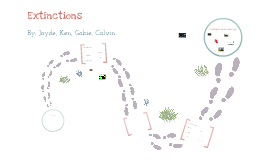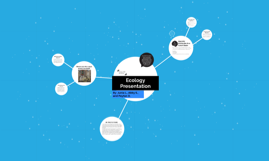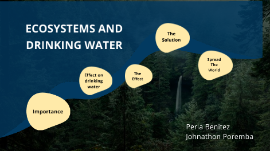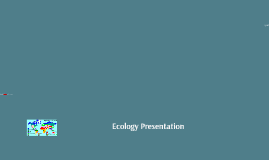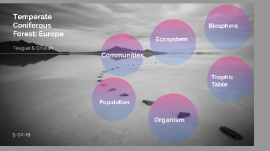Ecology Presentation
Transcript: Ecology Presentation Ecology: The study of how organisms relate to each other Biome: A large community of organisms occupying a major habitat. Examples: Forest and Tundra 5 major biomes of the world Tundra: Coldest biome in the world. Average of -34 degrees Celsius in the winter. Animals adapt to handle long, cold winters and to breed and raise young quickly in the summer. Niches of the Tundra There aren't many plants that grow in the arctic because of it's wild temperature, but the main producer is reindeer moss, a type of lichen. It is named reindeer moss because it is used for pastures for reindeer, moose, caribou, and musk oxen. Polar bears The polar bears niche is to eat walruses, fish,and seals. Desert: Arid deserts generally occur at low latitudes and can be found in North-America, South-America, Africa and Southern Asia. Rainfall is less than 50 cm/year. It's made up of mostly reptiles. Niches of the desert The main producer in a desert is the cactus. They can survive with little water and they store water inside of themselves. Animals try to find a way to get to the water without getting hurt by the castuses thorns. Rattlesnake A rattlesnake's niche is to eats rats, lizards, and birds. It lives among the low-lying bushes in a desert shrub habitat. It is active at dawn and dusk. Its predator is the roadrunner. Forest: There are 3 main types of forest. The Boreal, or Taiga forest, is commonly found in Europe, Asia, Siberia, and North-America, because of their short, warm summers and long winters. Niche of the Boreal Forest The main producers of the Boreal forest are oak trees which produce acorns that animals eat. Tropical Rainforest: The rainforest is the most ecologically rich of the world's biomes. Daylight lasts for 12 hours. There isn't winter because it is the same temperature all year long. It also hosts the largest variety of life forms in all of nature. Niches of the Rainforest There are many producer of the rainforest that range from avocados to shrubs to banana trees. Chimpanzees Niche A chimps niche is to eat fruits, stems, insects, small animals. They can also eat larger prey, such as pigs, baboons and other primates. Temperate Deciduous Forest: Temperate deciduous forest are a close relative of the Boreal biome and can be found in areas with a milder, shorter winter season. Evergreen, maple, elm, oak and ceder trees are in these types of forest. Racoon's Niche They are omnivorous and eat a variety of foods, including frogs, fish, amphibians, insects, eggs, mice, berries, nuts, vegetation and corn. Grassland: A grassland is a semi-arid area with little to no trees. The 3 types of grasslands are prairies, steppes and savannas. Prairies: Prairies are often humid and covered in tall grass. There are few trees, but the soil is very rich and great for plant growth. Steppe: A steppe grassland is usually found in areas of the world which are less prone to moisture. The grass is generally shorter than the prairie grassland. Most of the animals on a steppe grassland are grazing mammals like antelope. Savanna: The savanna is known for the warm and dry climates with long droughts. Plants in the savanna can store water for days because of the long droughts and shortages of water. Niches of the Grassland Most of the niches in the grassland include shrubs and grass. Elephant's Niche The elephants use their trunks as a tool to store water and take bark off of trees. As elephants travel they stir up small animals making it easier for birds to get food. Aquatic Biome: The final biome is the Aquatic Biome. It is also the largest biome. It is split up into two regions. The first is the freshwater region which includes lakes, ponds and rivers. The other region is the marine region which is coral reefs and oceans. Quiz Niches in the Temperate Deciduous Forest The main producers of the deciduous forest are the Oak tree, Eglantine which is a shrub that can grow up to 110 feet tall, and Birch Trees. Symbiotic Relationships: Long term relationship between 2 species in an ecosystem.








